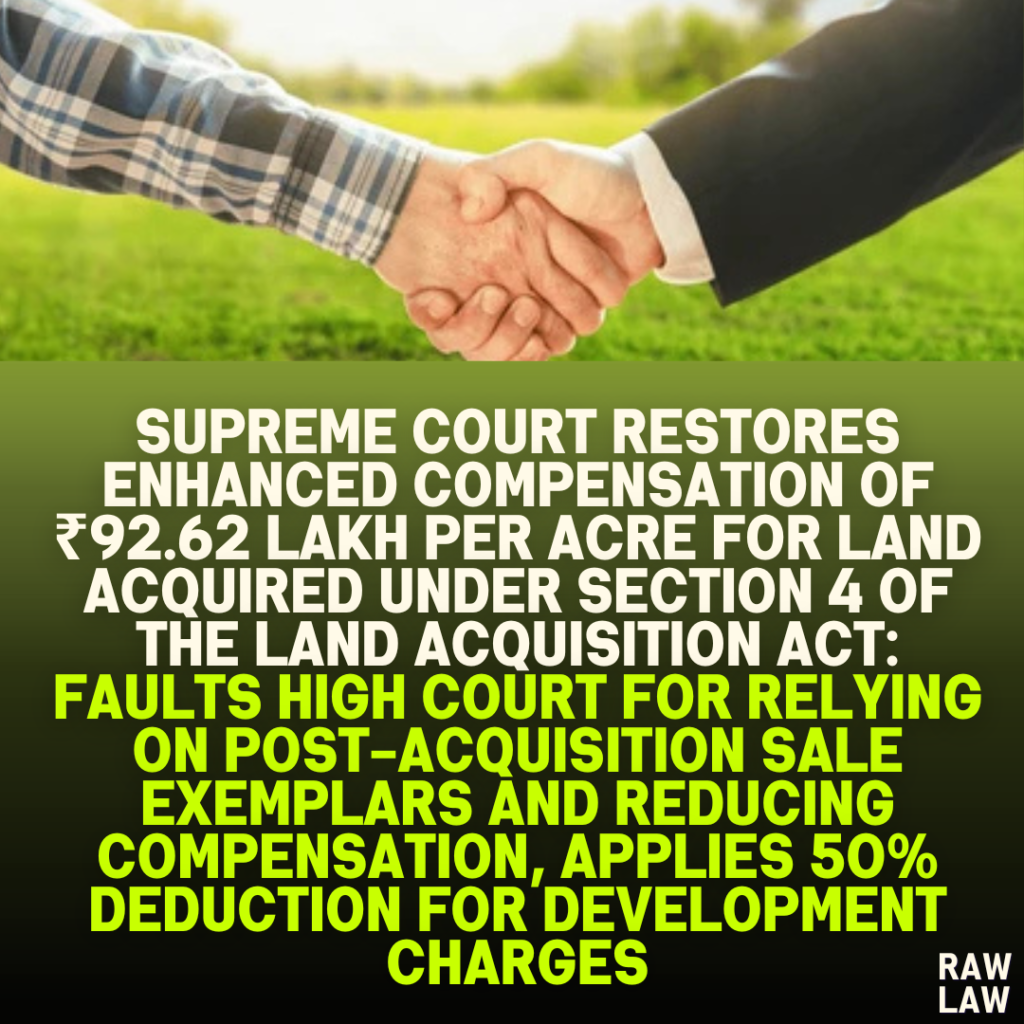Court’s Decision:
The Supreme Court set aside the Punjab and Haryana High Court’s judgment, which had reduced the compensation granted by the Reference Court for the acquisition of land. The Court restored the compensation amount determined by the Reference Court, ruling that it was aligned with market value and the land’s potential. The compensation must be paid within eight weeks with statutory benefits.
Facts:
The dispute involved landowners whose land, located in Tauru village, Mewat District, Haryana, was acquired for public purposes under Section 4 of the Land Acquisition Act, 1894. The acquisition was part of a project for developing Residential and Utility Areas. The Land Acquisition Collector (LAC) initially awarded compensation at Rupees 45,00,000/- per acre, which was increased by the Reference Court to Rupees 92,62,500/- per acre. The Punjab and Haryana High Court, however, reduced the compensation, restoring the LAC’s initial award. Dissatisfied with this, the landowners appealed to the Supreme Court.
Issues:
- Whether the appellants were entitled to a higher rate of compensation.
- How should the quantum of such compensation be calculated?
Petitioner’s Arguments:
The petitioners argued that the acquired land had immense potential, given its proximity to municipal amenities, the Sohna-Tauru bypass, and the Gurgaon-National Capital Region. They contended that the Reference Court had correctly enhanced the compensation based on comparable sale exemplars, particularly Ex. P76 and Ex. P3, which were more representative of the land’s value.
Respondent’s Arguments:
The respondents, represented by the State, argued that the sale deeds relied upon by the petitioners were not comparable, as they involved much smaller plots. They further argued that the High Court had rightly relied on sales instances provided by the State, which they claimed were more appropriate for determining compensation.
Analysis of the Law:
The Court focused on the principles of determining compensation under Section 23(1) of the Land Acquisition Act, 1894, emphasizing the importance of “market value” at the time of acquisition. The Court also highlighted that sale exemplars executed after the Section 4 notification should generally be excluded, as they may not reflect the accurate market value due to the ongoing acquisition process. The Court carefully examined the sale exemplars from both parties, ultimately deciding that Ex. P5, which reflected a value of Rupees 1,81,33,867 per acre, was the most suitable basis for calculating compensation.
Precedent Analysis:
The Court relied on earlier rulings, including Mehrawal Khewaji Trust v. State of Punjab and Kanwar Singh v. Union of India, to establish that the highest bona fide sale exemplar should be considered when determining compensation. The Court also reiterated that post-notification sales can only be considered in the absence of better evidence.
Court’s Reasoning:
The Court found that the High Court had erred in relying on sale exemplars that were executed after the acquisition had commenced. It held that the Reference Court had correctly estimated the market value by considering the best available sale exemplars, despite a few limitations. The Court applied a 50% deduction towards development charges, finding it appropriate given the land’s potential and its proximity to major infrastructure projects.
Conclusion:
The Supreme Court allowed the appeals, restoring the compensation granted by the Reference Court at Rupees 92,62,500/- per acre. The Court directed that the compensation be paid within eight weeks, along with statutory benefits, including interest.
Implications:
This ruling reaffirms the principle that landowners are entitled to the highest compensation based on bona fide sale exemplars and underscores the importance of adhering to market value when calculating compensation for land acquired under public projects. The decision also highlights the importance of selecting appropriate sale exemplars that reflect the true potential and value of the land at the time of acquisition.



